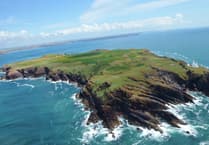A gathering of renewable energy developers is rarely headline-grabbing, but a meeting at Swansea’s new indoor arena was another step towards what some hope will be a significant new industry for South West Wales.
At the meeting around 25 to 30 developers and consultants found out more about plans by the UK Crown Estate to lease three areas of the Celtic Sea, west of Lundy Island, for floating offshore wind farms. A competitive tender process for bidders is now under way.
“The general atmosphere was quite positive – I think it was a really significant step in the right direction,” said a renewable energy figure who was present.
Offshore wind turbines are traditionally fixed to the seabed. Floating offshore one, as the name suggests, aren’t. While the technology is relatively new, and expensive, floating offshore turbines would operate in deeper water thereby opening up new areas of the sea to generate renewable electricity.
A new “freeport” – Celtic Freeport – is being established partly to support investment in the deep-water port at Port Talbot and at the Port of Milford Haven, Pembrokeshire, to maximise floating offshore wind opportunities.
Associated British Ports (APB), which owns Port Talbot port, described floating offshore wind as a “once-in-a-generation opportunity” which could create thousands of jobs.
The UK Government is expected to announce shortly which regions will receive a share of £160 million to boost port infrastructure to handle floating offshore wind, with Wales and Scotland key frontrunners. It has also committed to providing higher subsidies for floating offshore wind energy generation than currently.
The Crown Estate originally identified four areas in the Celtic Sea for floating offshore wind, before deciding upon three.
It envisages around 260 large turbines across the three sites by 2035, creating 4,000 jobs but requiring a vast sum of investment of up to £19 billion.
More areas for more turbines would be selected in the future.
The Crown Estate has also agreed to progress commercial agreements with three demonstration projects in the Celtic Sea, and it has carried out habitat studies which will give developers more clarity about what is be expected of them in terms of environmental requirements.
“The Celtic Sea region presents an exceptional opportunity for floating offshore wind development, thanks to its abundant wind resources,” said a Crown Estate report.

“As the market develops and future leasing brings additional projects to the Celtic Sea, a much broader economic opportunity opens up. At ports – and in their hinterland – where the basic requirements for handling floating turbines and their foundations has been established, there is a clear opportunity to assemble and manufacture floating foundations and other high value activities.”
A spokesperson for ABP said it was planning major investment at Port Talbot to deal with floating offshore wind – from turbine manufacture and assembly, to the launch of floating foundations, and the storage of wind turbine components – and that it has been awarded some Welsh Government funding for this work.
She said: “Port Talbot’s deep-water harbour and large amounts of develop-able land make it an ideal location to support floating offshore wind. But this is a global market, and ‘first mover’ advantage – making sure ports are ready first – is key to capturing this opportunity.
“Other ports in Wales, such as Milford Haven and neighbouring Swansea, will also have an important role to play in facilitating the growth of this new sector.”
Jessica Hooper, director of RenewableUK Cymru, a trade body, said the confirmation of further areas for future development in the Celtic Sea was important.
“Developers need to know there is an order book,” she said.
Mrs Hooper said the development of onshore grid connection points to handle Celtic Sea-generated electricity would be critical, and that developers also needed to know how much money would be available in the UK Government’s next renewable energy subsidy pot, known as allocation rounds.
Subsidies can attract controversy. They increase consumers’ energy bills, but low-carbon energy developers say they need them to commit to very expensive projects, and that costs generally come down as sectors grow and mature.
Subsidies are important – the UK Government pulled the plug on the proposed Swansea Bay Tidal Lagoon, which promised jobs and a new industry, on subsidy cost grounds.
The impending subsidy – or “strike price”, as it is known – for floating offshore wind is more than double that of fixed offshore wind and nearly treble that of solar.
Asked if it was too expensive, Mrs Hooper said: “It is expensive now, but it should be a really sharp curve in terms of learning. It is a nascent technology, but for the most part it’s based on two tried and tested technologies – oil and gas platforms, and wind (energy). Also, we are running out of seabed for fixed offshore wind. To ‘debarbonise’ we have to look to deeper waters.”
There are different design options for floating offshore wind turbines, and one company which has been testing and operating them – Equinor – has been impressed with the results.
In 2012 Equinor trialled a single floating offshore wind turbine in Norway, where the company is based, before installing five large turbines off the coast of Scotland in 2017. An Equinor spokeswoman said costs came down by 70% with the development of the 2017 project.
She also said the Scottish project, called Hywind Scotland, has generated maximum power 54% of the time over the six years the turbines been operating.
Fixed offshore wind turbines tend to generate maximum power around 40% of the time, on average, while it’s less for onshore wind and less again for solar. All this is intermittent electricity generation, though, which complicates the process of ensuring that supply meets demand.
The Equinor spokeswoman said: “We have been extremely pleased with the performance of Hywind Scotland, and have learned a lot from developing and operating the world’s first floating wind farm.”
She said there was a greater need for port infrastructure with floating compared to fixed offshore wind.
“For floating wind, the assembly of the wind turbines onto the substructures is done at the quayside within a port,” she said.
“This is this is different to bottom-fixed wind where most of the assembly is done offshore at the wind farm location. This means that for floating wind we need ports with deep water and a larger area at the port to store and assemble the structures.”
Equinor said it was very keen to invest off the coast of South West Wales.
The spokeswoman said: “For the Celtic Sea there is an urgent need for investment into ports so that the infrastructure is ready in time for the first commercial-scale projects.”
Just who benefits if floating offshore wind does take off remains to be seen. RenewableUK Cymru’s Mrs Hooper said attendees at the Swansea Arena event were a mix of UK, Republic of Ireland and overseas developers.
“If we don’t do it, we are going to lose that opportunity,” she said. “With onshore wind, in the 1970s and 80s, we had the technology, and turbine manufacturing was for the most part British. It all ended up in places like Sweden, the Netherlands and Germany.”

The UK Government wants to fully decarbonise electricity generation by 2035, and offshore wind – mainly fixed offshore wind – would have to play a significant role.
Infrastructure projects of all types can cause unease, anger and hostility. Visual impact concerns are voiced about wind farms, although ones floating far out at sea would be unlikely to be very visible.
Impact on bird life is another important factor. Conservation charity RSPB Cymru said offshore wind would play a big part in the UK’s energy transition and compliance with “net zero” targets.
Anne Smith, the charity’s head of nature of policy and casework, said it was crucial that wildlife and habitats were not lost or damaged. She said: “This means that we need to protect the most sensitive and important areas for nature from inappropriate development.”
She added that Wales was home to large colonies of globally important seabirds, such as Manx shearwater nesting on Welsh islands which made up more than half of the world’s population.
“The importance of Wales and the Celtic Sea to the state of the UK’s seabirds is greater than ever, considering the catastrophic declines in some of the Scottish sea bird colonies,” she said. Bird ‘flu, she added, added a new threat.
“With these pressures and threats facing seabirds in Wales and the UK, it is vital that we have better strategic planning of marine development,” she said.
The UK Government is backing a new floating offshore wind sector. The Welsh Government said it had significant economic potential, and that Milford Haven Port Authority has been offered a grant, as well as APB in Port Talbot, to help prepare for a potential new industry.
Neath Port Talbot Council chiefs have their fingers crossed for floating offshore wind.
Its chief executive, Karen Jones, said: “We’re mapping the supply chain right across the South West Wales, however it is also wider than that because the supply chain for this industry will need to be very significant, therefore a number of businesses across the whole of Wales would benefit.
“Also, on the back of the news that Tata Steel is proposing a significant decarbonisation programme, the aspirations of the Celtic Freeport could become even more important to our future economy.”




